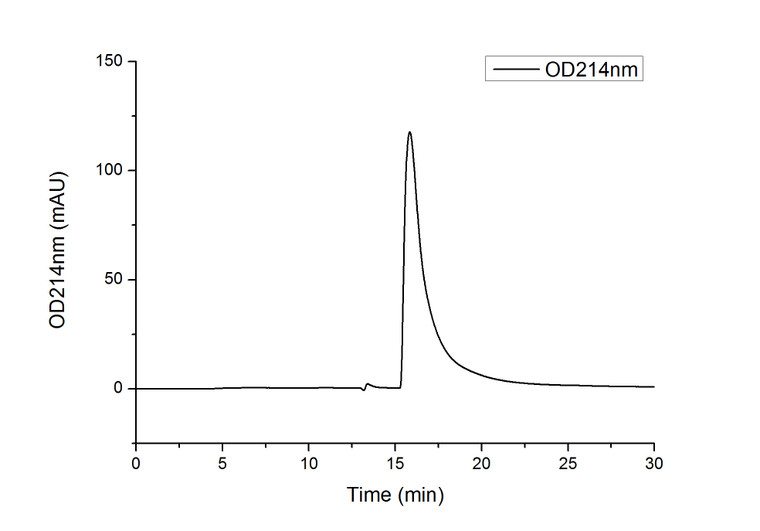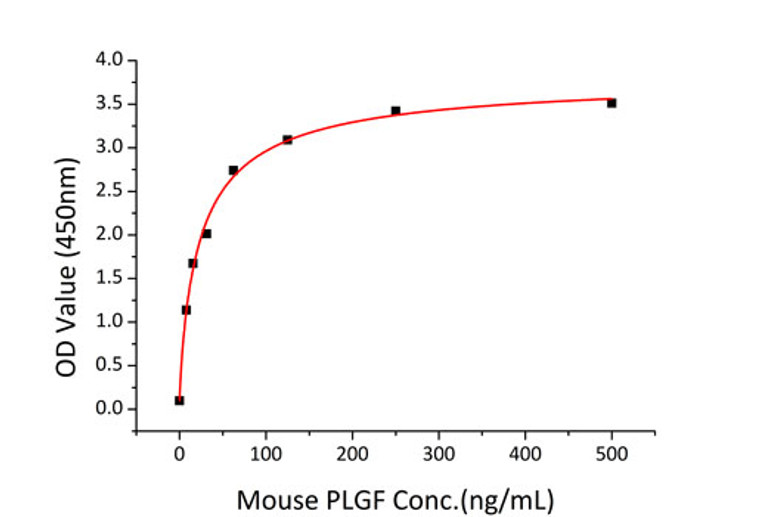| Host: |
HEK293 cells |
| Reactivity: |
Human |
| Note: |
STRICTLY FOR FURTHER SCIENTIFIC RESEARCH USE ONLY (RUO). MUST NOT TO BE USED IN DIAGNOSTIC OR THERAPEUTIC APPLICATIONS. |
| Short Description: |
Recombinant-Human FLT-1/VEGFR-1-C-His protein was developed from hek293 cells and has a target region of C-His. For use in research applications. |
| Formulation: |
Lyophilized from a 0.22 Mu m filtered solution of PBS, pH 7.4. Contact us for customized product form or formulation. |
| Immunoreactivity: |
Measured by its binding ability in a functional ELISA. Immobilized Recombinant Human VEGFR1 at 500 ng/mL (100 Mu L/well) can bind Recombinant Mouse PLGF with a linear range of 12-49 ng/mL.2. Measured by its ability to inhibit the VEGF-dependent proli |
| Gene Symbol: |
FLT1 |
| Gene ID: |
2321 |
| Uniprot ID: |
VGFR1_HUMAN |
| Immunogen: |
Recombinant Human FLT-1/VEGFR-1 Protein is produced by HEK293 cells expression system. The target protein is expressed with sequence (Met1-Asn756) of human VEGFR1/Flt-1 (Accession #NP_002010.1) fused with a 8×His tag at the C-terminus. |
| Post Translational Modifications | N-glycosylated. Ubiquitinated after VEGFA-mediated autophosphorylation, leading to proteolytic degradation. Autophosphorylated on tyrosine residues upon ligand binding. Autophosphorylation occurs in trans, i.e. one subunit of the dimeric receptor phosphorylates tyrosine residues on the other subunit. Phosphorylation at Tyr-1169 is important for interaction with PLCG. Phosphorylation at Tyr-1213 is important for interaction with PIK3R1, PTPN11, GRB2, and PLCG. Phosphorylation at Tyr-1333 is important for endocytosis and for interaction with CBL, NCK1 and CRK. Is probably dephosphorylated by PTPRB. |
| Function | Tyrosine-protein kinase that acts as a cell-surface receptor for VEGFA, VEGFB and PGF, and plays an essential role in the development of embryonic vasculature, the regulation of angiogenesis, cell survival, cell migration, macrophage function, chemotaxis, and cancer cell invasion. Acts as a positive regulator of postnatal retinal hyaloid vessel regression. May play an essential role as a negative regulator of embryonic angiogenesis by inhibiting excessive proliferation of endothelial cells. Can promote endothelial cell proliferation, survival and angiogenesis in adulthood. Its function in promoting cell proliferation seems to be cell-type specific. Promotes PGF-mediated proliferation of endothelial cells, proliferation of some types of cancer cells, but does not promote proliferation of normal fibroblasts (in vitro). Has very high affinity for VEGFA and relatively low protein kinase activity.may function as a negative regulator of VEGFA signaling by limiting the amount of free VEGFA and preventing its binding to KDR. Modulates KDR signaling by forming heterodimers with KDR. Ligand binding leads to the activation of several signaling cascades. Activation of PLCG leads to the production of the cellular signaling molecules diacylglycerol and inositol 1,4,5-trisphosphate and the activation of protein kinase C. Mediates phosphorylation of PIK3R1, the regulatory subunit of phosphatidylinositol 3-kinase, leading to activation of phosphatidylinositol kinase and the downstream signaling pathway. Mediates activation of MAPK1/ERK2, MAPK3/ERK1 and the MAP kinase signaling pathway, as well as of the AKT1 signaling pathway. Phosphorylates SRC and YES1, and may also phosphorylate CBL. Promotes phosphorylation of AKT1 at 'Ser-473'. Promotes phosphorylation of PTK2/FAK1. Isoform 1: Phosphorylates PLCG. Isoform 2: May function as decoy receptor for VEGFA. Isoform 3: May function as decoy receptor for VEGFA. Isoform 4: May function as decoy receptor for VEGFA. Isoform 7: Has a truncated kinase domain.it increases phosphorylation of SRC at 'Tyr-418' by unknown means and promotes tumor cell invasion. |
| Protein Name | Vascular Endothelial Growth Factor Receptor 1Vegfr-1Fms-Like Tyrosine Kinase 1Flt-1Tyrosine-Protein Kinase FrtTyrosine-Protein Kinase Receptor FltFltVascular Permeability Factor Receptor |
| Database Links | Reactome: R-HSA-194306Reactome: R-HSA-195399 |
| Cellular Localisation | Isoform 1: Cell MembraneSingle-Pass Type I Membrane ProteinEndosomeAutophosphorylation Promotes Ubiquitination And EndocytosisIsoform 2: SecretedIsoform 3: SecretedIsoform 4: SecretedIsoform 5: CytoplasmIsoform 6: CytoplasmIsoform 7: Cytoplasm |
| Alternative Protein Names | Vascular Endothelial Growth Factor Receptor 1 proteinVegfr-1 proteinFms-Like Tyrosine Kinase 1 proteinFlt-1 proteinTyrosine-Protein Kinase Frt proteinTyrosine-Protein Kinase Receptor Flt proteinFlt proteinVascular Permeability Factor Receptor proteinFLT1 proteinFLT proteinFRT proteinVEGFR1 protein |
Information sourced from Uniprot.org
12 months for antibodies. 6 months for ELISA Kits. Please see website T&Cs for further guidance













